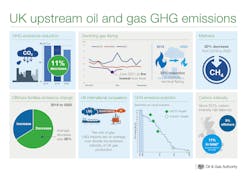UK upstream sector making progress on emissions cuts
Offshore staff
LONDON – Britain’s Oil and Gas Authority (OGA) has published its inaugural emissions monitoring report. This is part of the authority’s program to monitor and benchmark the UK offshore industry on emissions, in support of the government’s target of reaching net zero by 2050.
The report will also help chart the industry’s progress in delivering commitments undertaken in the North Sea Transition Deal (NSTD) the industry signed with the government earlier this year.
Under the deal, the industry committed to cut emissions from offshore production 10% by 2025, 25% by 2027, and 50% by 2030, against a 2018 baseline.
According to the report, the early goals appear to be within reach, with UK upstream greenhouse gas emissions falling 11% between 2018 and 2020 due to abatement initiatives, decreased offshore activity, and the permanent shutdown of various high emitter production facilities.
During 2019-20, emissions fell at two-thirds of UK offshore installations, with overall offshore flare volumes down 23% last year.
But going forward, the OGA cautioned, there needs to be an emphasis on platform electrification, further reductions in flaring and venting, retrofitting platforms with more energy-efficient equipment, progressing carbon capture and storage projects, integration with hydrogen, and more efficient operations.
This year, the OGA claims its various interventions have helped the industry avoid producing 993,000 metric tons (1.095 MM tons) of lifetime CO2e.
10/14/2021
